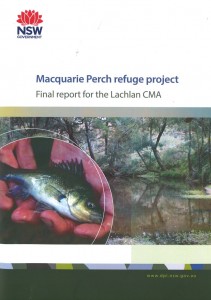
Species and Communities of Special Significance
In this category are threatened species, endangered ecological communities and species of conservation concern, including the lowland Lachlan River aquatic ecological community. Macquarie Perch, Southern Pygmy Perch, Olive Perchlet, Purple-spotted Gudgeon, Silver Perch and Murray Cod have all been identified as native fish species of significance in the Lachlan, and are currently under threat. Silver Perch is listed as a vulnerable species in NSW under the NSW Fisheries Management Act 1994. This species inhabits warm, sluggish, standing waters with cover provided by woody debris and reeds as well as fast-flowing, turbid waters (Koehn and O’Connor 1990). Little is known about its ecological requirements in the wild although some information is available from breeding in captivity. Recruitment of silver perch appears to be localised and opportunistic (Morris et al. 2001). Whilst spawning can occur during non-flood conditions, spawning activity and recruitment success may be significantly increased during floods and higher flows. The larvae and juveniles use floodplain habitats. Adults and juveniles feed on small aquatic insects, molluscs, earthworms and green algae while larvae feed on zooplankton (Merrick 1996).
The Macquarie Perch (Macquaria australasica), listed as endangered under the Commonwealth Environmental Protection and Biodiversity Conservation Act (1999), with habitat modifications impacting on populations through barriers to passage, reduction in floodplain habitat, alteration to flow regimes, reduction of instream habitat, and reduction in water quality (Lawrence 1991). Macquarie Perch spawn in late spring/summer with fish depositing eggs above fast-flowing sections of river. The preferred habitat is cool, shaded, upland streams with deep rocky pools and good riparian cover.
The species now seems to be confined to the upper reaches of the Lachlan, above Wyangala Dam. Local Land Services, in partnership with other agencies, continues to implement a habitat rehabilitation and reintroduction program to protect and promote Macquarie Perch populations in the upper Lachlan. As an integral first step, the program involved field sampling and analyses to quantify the habitat needs of Macquarie Perch in the upper Lachlan, and mapping activities that described the distribution and abundance of those habitat features. The outcomes of this habitat suitability analysis and mapping can be read in a report to the Lachlan Catchment Management Authority, titled ‘A scientific approach to developing habitat rehabilitation strategies in aquatic environments: A case study on the endangered Macquarie Perch (Macquaria australasica) in the Lachlan Catchment‘ (Gilligan et al., 2010). Later components of the program, such as the captive breeding trials, are also discussed in the ‘Macquarie Perch refuge project: final report for the Lachlan CMA’.
The Murray Cod (Maccullochella peeli peeli) is listed as vulnerable under the Commonwealth Environmental Protection and Biodiversity Conservation Act (1999). The Murray Cod is a long-lived predator and the largest freshwater fish found in Australia. It occurs in a wide range of warm water habitats that range from clear, rocky streams to slow flowing turbid rivers and billabongs, but tends to mainly inhabit the mid to lower Lachlan at present. The Native Fish Strategy for the Murray-Darling 2002–2012 outlines a number of important initiatives that are directly relevant to the Murray Cod. They include the allocation of environmental flows, habitat restoration work, the abatement of cold water pollution, the provision of fishways and fish passage, the establishment of an aquatic reserve system, carp management and management of other alien fish species.
Other species of significance include the Australasian Bittern, Brolga, Blue-billed Duck and Freckled Duck which are listed as vulnerable at the state level.

